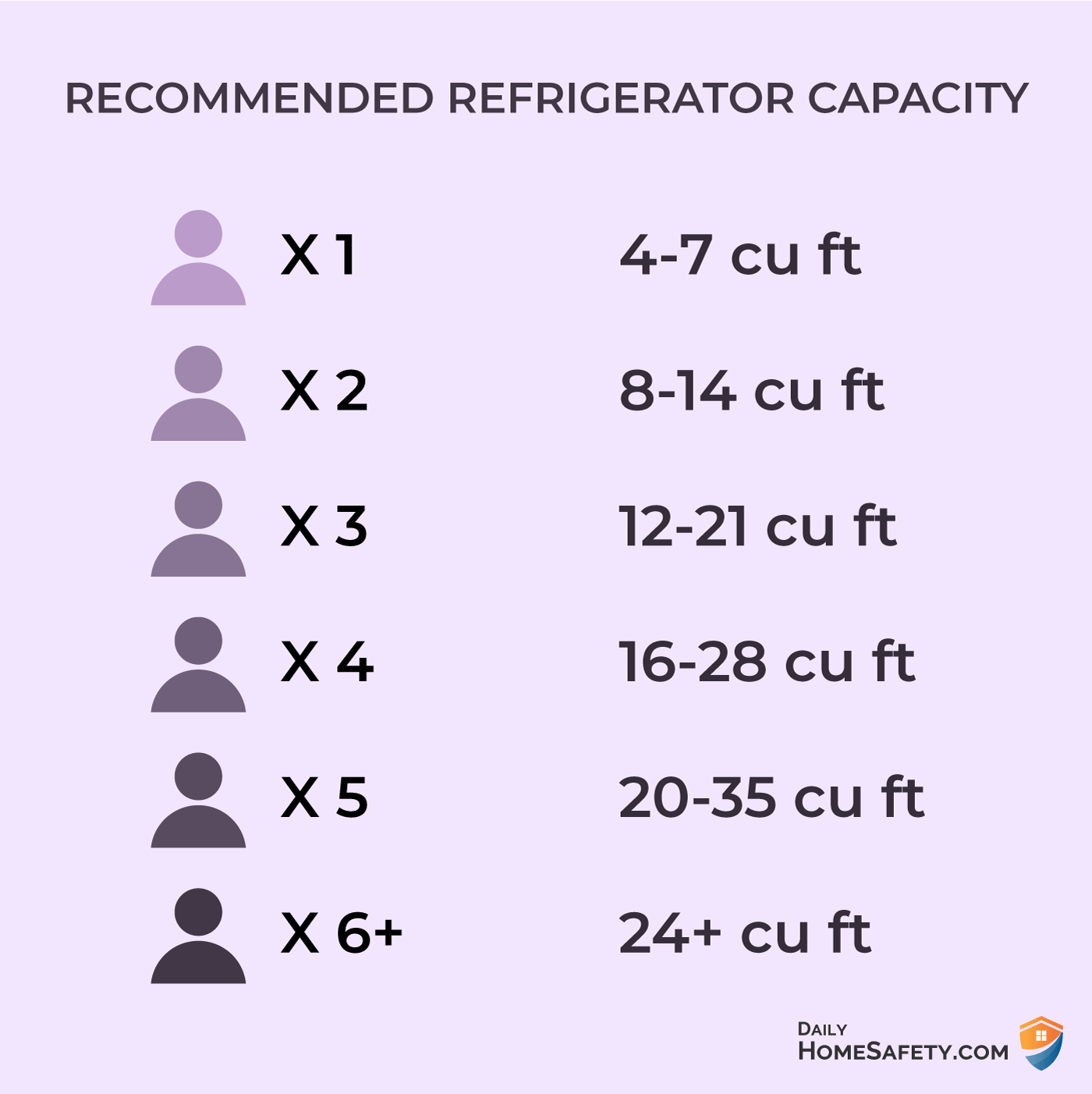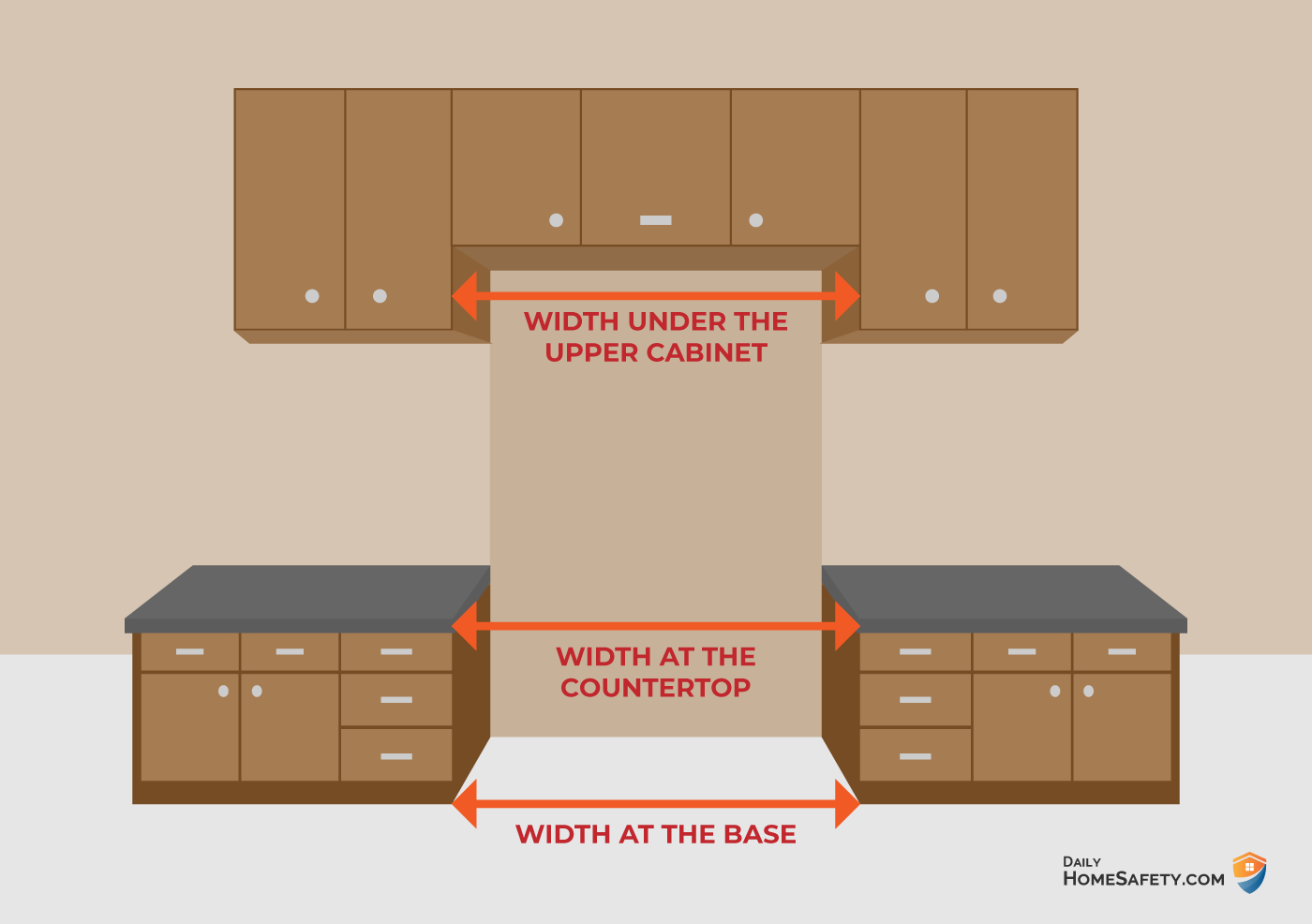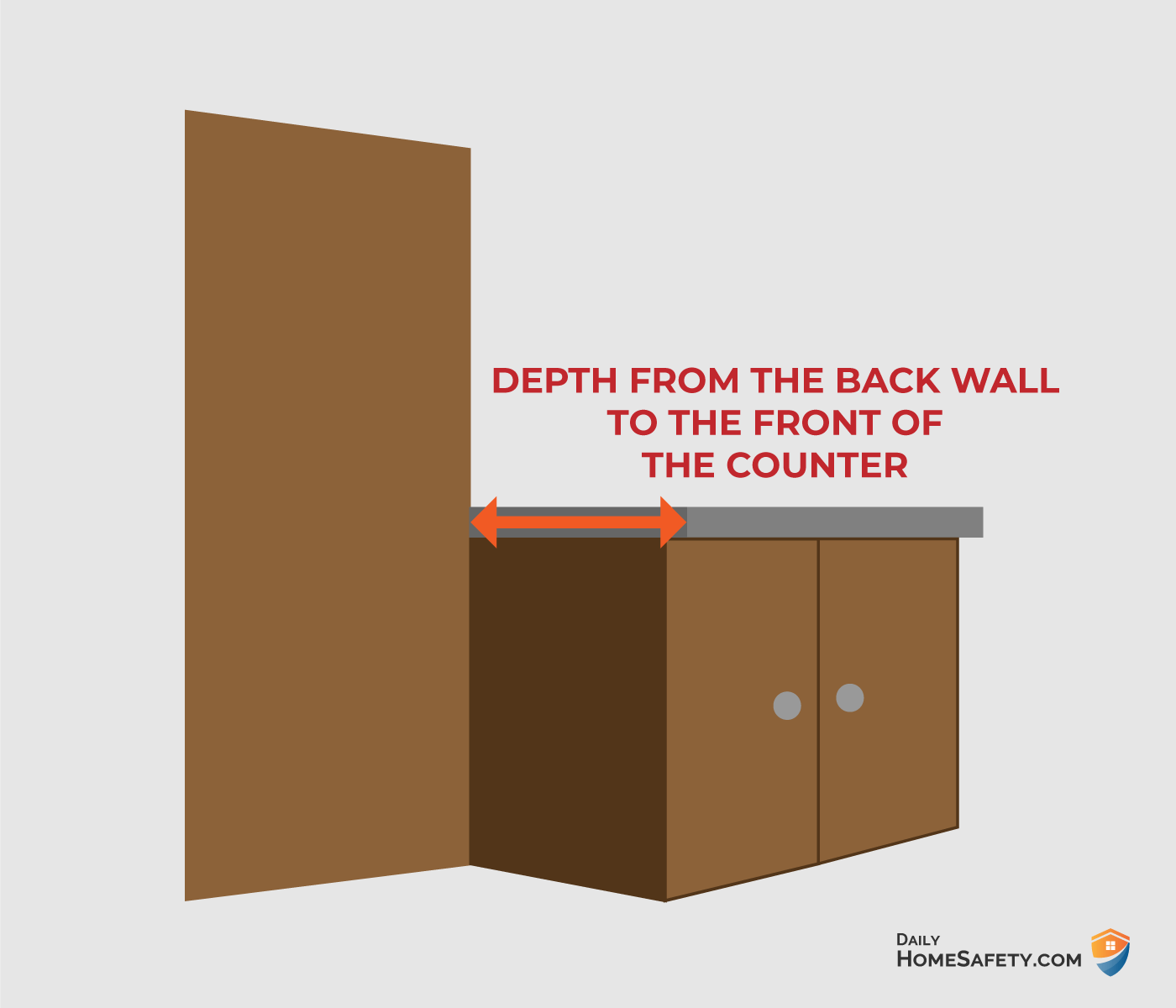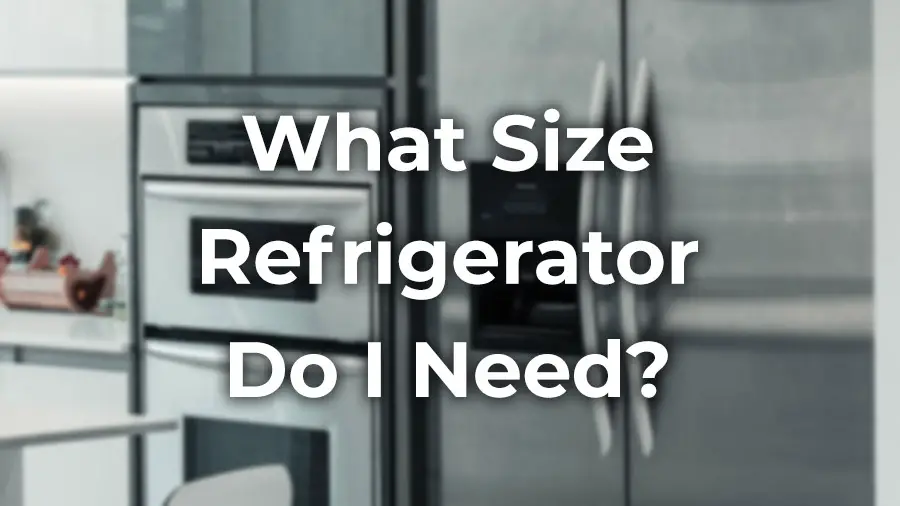Choosing the right size refrigerator is key because you’re likely to use it on a daily basis for a long period of time.
Unfortunately, picking the wrong size refrigerator is not uncommon at all and you can’t really do much about it once you have it in your kitchen.
This is why it’s so important to take the time to consider your needs and the unique features of your home.
By getting the right size refrigerator you can save yourself and your family a lot of annoyance and frustration.
In this article, you’ll find everything you should know to determine the exact size of refrigerator you need in your home.
The Capacity You Need: Refrigerator Size Based On Family Size
As a general rule of thumb, the recommended capacity is 4-7 cubic feet per person in the household.
Don’t forget that you’re likely to use your new refrigerator for at least a decade, so plan ahead.
Think about how big your family will be in ten years’ time and choose the capacity accordingly.
Also, if you buy in bulk, regularly cook at home, or have many guests, you might need a larger size refrigerator that has enough storage space for all the groceries and prepared food.
Below you’ll find what size refrigerator you probably need for your family (in certain cases, the perfect capacity for you might differ from the suggested ones):
| Family Size (number of people) | Refrigerator Capacity (cu ft) |
| 1 person | 4-7 cu ft |
| 2 people | 8-14 cu ft |
| 3 people | 12-21 cu ft |
| 4 people | 16-28 cu ft |
| 5 people | 20-35 cu ft |
| 6+ people | 24+ cu ft |
Determining what capacity refrigerator you need is one of the most important steps when buying a new device.
You don’t want to be stuck with a too small fridge for years but you don’t want a unit with a capacity that significantly exceeds your needs either.
For example, a fridge with an 11 cubic feet capacity is usually enough for a college dorm (for two students). However, in the case of a big family, I wouldn’t go below 26 cubic feet.
If you’re more of a visual person, check out the following chart on refrigerator size by capacity to get an overview:

How to Calculate the Capacity of a Refrigerator?
Sometimes you may not have access to the information on volume provided by the manufacturer or want to determine the capacity of an existing unit.
In these cases, you need to calculate the gross capacity by measuring the inner dimensions of the device.
Here’s what you need to do to get the total volume of a refrigerator:
- first measure the inner width, height, and depth of the unit,
- then convert the dimensions to feet,
- finally, multiply these three values to get the capacity in cubic feet
To make things even easier, here’s a handy cubic feet calculator:
It’s useful to know that when it comes to capacity, most manufacturers apply the AHAM (Association of Home Appliance Manufacturers) standard that won’t really provide accurate information about food storage capacity.
Instead, it usually shows the gross capacity (total volume) of the refrigerator which is typically more than the storage volume.
Will the Refrigerator You Need Fit? Refrigerator Size & Available Space
After you’ve determined the volume size you need, the next step is to check the available space and make sure the model you want to buy will fit.
The scenario you want to avoid is buying the refrigerator with the capacity you need and realizing that it’s not compatible with your kitchen because it’s either too large or you can’t open the refrigerator doors fully.
That’s why I highly recommend that you measure the space where you want to install the refrigerator precisely and get the exact dimensions of the unit before buying.
Measure the Available Space
The size of the refrigerator you need may differ from the one that fits in your home. This is why measuring the space where you want to place your new device correctly is so important.
Here’s how you can determine the dimensions of the space available properly:
Height

As a first step, measure the height of the space from the floor to the lowest point of the cabinets.
Keep in mind that the floor and the bottom of the upper cabinets may be uneven. Therefore I suggest you make multiple height measurements (at least at the front and back of the cabinets) to find the smallest distance between the floor and the cabinets.
If there’s open space instead of cabinets, you can skip this step.
Width

Next, measure the width of the space at its narrowest points to determine the maximum width of the refrigerator.
Make sure you measure the distance under the upper kitchen cabinets, between the floor moldings, and at the countertop. Take a note of the smallest value.
Depth

Finally, you need to measure the depth of the cutout where you want to place your refrigerator.
Generally, the depth is the distance from the back wall to the front of the counter(top). In most cases, the distance should be no more than the refrigerator depth without doors and handles.
Breathing Space
Keep in mind that it’s recommended that you leave a distance of at least 2 inches behind the unit, ½ inch on both sides, and 1 inch at the top. These values may slightly vary between models, so don’t forget to check the manufacturer’s recommendations.
To get the perfect refrigerator size that will fit, you have to subtract these values from the dimensions of the cabinet cutout.
Here’s an example:
If the cabinet cutout is 36 inches wide, has a height of 75 inches, and a depth of 25 inches, the dimensions of your new fridge should be the following:
- maximum refrigerator width: 36 inches - (2 x ½ inch) = 35 inches
- maximum refrigerator height: 75 inches - 1 inch = 74 inches
- refrigerator depth without doors: 25 inches - 2 inches = 23 inches or more
If you ignore breathing space, your fridge will be more prone to failures and inefficient operation.
For example, while a 36-inch wide refrigerator may fit in a 36-inch opening if you’re lucky, there will be zero distance between the unit and the cabinet or wall. This is not recommended at all.
Regarding depth, the most important thing to consider is that in most cases the refrigerator box (the refrigerator without doors) should extend beyond the countertop. Otherwise, you may not be able to fully open the fridge doors.
FYI: I don’t recommend that you measure the dimensions of your existing refrigerator instead of the space it occupies because that may lead to incorrect conclusions and the exclusion of models that would otherwise fit into your kitchen.
Measure Your Doorways
Before buying your new refrigerator, it’s a good idea to plan the path in your home on which it will be delivered to its final place. Find the route with the lowest number of doorways and obstacles.
Measure the width of all doorways (jamb to jamb) along the way to make sure the refrigerator will fit through. You might need to remove the doors from their hinges to be able to carry the fridge through the opening.
If you have a kitchen island on the delivery path, you also need to measure the space around it.
Determine the Dimensions of the Refrigerator
Finally, you need to get the exact dimensions of the refrigerator. In most cases, you don’t have to make any measurements as the manufacturers usually provide you with the specifications on their websites. All you need to know is the model number.
Anyway, here’s what you need to measure if you don’t have the manufacturer’s data:
- width
- width with doors open
- height with hinges
- depth with closed doors (including and excluding handles)
- depth without doors
- depth with doors open
- depth with drawers open (including freezer drawers)

After you’re done with the refrigerator measurements, you need to check whether the size of the fridge is a fit for its final location.
Make sure the refrigerator doors will swing open completely without hitting any obstacles, such as walls, kitchen islands, cabinets, counters, etc.
Some models won’t allow you to pull out the drawers unless you fully open the doors. If the unit you want to buy has a depth that’s too large for your kitchen space, you can still opt for a counter depth refrigerator.
Keep in mind that the refrigerator box typically has to extend slightly beyond the counter to be able to open the doors appropriately.
Pay special attention to the hinges: make sure they will operate flawlessly without preventing the fridge from fitting under the cabinet.
Remember: it’s recommended that you allow for at least 1 inch at the top and ½ inch on both sides. Also, make sure there are at least 2 inches of clearance behind the unit for air circulation.
If you’re planning to install the refrigerator next to a wall, you’ll usually need at least 4 inches of space to be able to swing the door fully open.
The above-mentioned values are not strict rules but rather for reference only, as breathing space requirements can vary from model to model. Therefore make sure you always check and follow the manufacturer’s recommendations.
Also, keep in mind that you shouldn’t place the refrigerator near a heat source, such as the oven.
Standard Refrigerator Sizes By Configuration
The standard fridge size can vary widely depending on the manufacturer, the configuration, and the features.
Standard refrigerator height is between 66 and 71 inches, the standard width ranges from 24 to 36 inches, and the standard depth without handles falls between 27 and 35 inches.
Here are some standard refrigerator dimension ranges by configuration:
Side-by-side refrigerators
A side-by-side refrigerator is 31 to 39 inches wide, 66 to 71 inches tall, and 28 to 34 inches deep on average.
French door refrigerators
The average size of a French door refrigerator is similar to the size of a side-by-side fridge. It usually has a width of 30 to 36 inches, a height of 67 to 70 inches, and a depth of 29 to 35 inches.
Top-freezer refrigerators
Top-freezer refrigerators are somewhat smaller than the previous configurations. They have an average width of 24 to 36 inches, a height of 64 to 69 inches, and a depth of 27 to 34 inches.
Bottom-freezer refrigerators
Bottom-freezer fridges are 24 to 36 inches wide, 63 to 70 inches tall, and 28 to 34 inches deep.
Mini fridges
Although a mini fridge (or a compact refrigerator) has a considerably lower capacity than a standard size fridge, it can be a reasonable choice for tight spaces (and for one person). Mini fridges have an average width of 17 to 21 inches, a height of 20 to 35 inches, and a depth of 18 to 22 inches.
Note: counter-depth fridges are usually about 28-30 inches deep, so they’re a few inches shallower than standard ones.
Standard Refrigerator Size Chart
Now let’s see a visual representation of the above data:
Power Consumption of Different Sizes of Refrigerators
When you’re trying to figure out what size refrigerator you need, power consumption is another important consideration.
As a general rule of thumb, old refrigerators consume more energy than modern ones, and fridges with a larger capacity use more electricity than units with a smaller capacity.
The electricity consumption of modern average-size refrigerators typically ranges from 345 to 812 kilowatt-hour (kWh) per year. There are many factors that can significantly affect consumption, and you can find the main ones below the tables.
Average Yearly Energy Consumption By Refrigerator Size
| Refrigerator Capacity (cu ft) | Yearly Electricity Use (kWh) |
| 2.7-8 cubic feet | 198-358 kWh |
| 9-13 cubic feet | 292-494 kWh |
| 14-19 cubic feet | 386-613 kWh |
| 20-24 cubic feet | 399-669 kWh |
| 25-27 cubic feet | 562-772 kWh |
| 28-30 cubic feet | 643-885 kWh |
| 30-34 cubic feet | 710-938 kWh |
As you can see, refrigerators with a larger capacity generally use more electricity. That doesn’t mean you should choose a low-capacity fridge. Just go for the size that you need and opt for a model that’s Energy Star certified.
Average Yearly Energy Consumption By Refrigerator Type (Average Size Models)
| Refrigerator Configuration | Yearly Electricity Use (kWh) |
| Mini fridge | 204-327 kWh |
| French door | 547-772 kWh |
| Side-by-side | 615-812 kWh |
| Top-freezer | 345-579 kWh |
| Bottom-freezer (single door) | 395-610 kWh |
If a low electricity bill is a priority, you may want to consider top-freezer or bottom-freezer models as they tend to consume less power than side-by-side and French door fridges.
Main Factors That Influence Power Consumption
- Configuration: Top-freezer and bottom-freezer refrigerators usually use less energy than side-by-side units (see above).
- Capacity: Higher capacity means larger space to cool and higher power consumption.
- Temperature: Fridges are less efficient in a warmer environment.
- Energy Efficiency: Models with the Energy Star logo consume less power.
- Temperature setting: The lower the fridge temperature is set, the higher the energy consumption.
- Defrosting: Although a manual defrost fridge consumes less energy than automatic models, it should be defrosted routinely (otherwise it can quickly become an energy hog).
- Ventilation: Poor ventilation can make your fridge less efficient and use more energy.
- Anti-sweat heaters: Fridges with this feature often consume a few percent more power.
While having some extra space in your refrigerator is useful, if your fridge is almost empty most of the time, you’re wasting energy.
Neither too small nor too large a refrigerator is ideal. This is why it’s important to think carefully about what you really need.
Whatever size refrigerator you choose, I highly recommend that you opt for a unit that is Energy Star certified. These models consume at least 15% less energy than the federal standard and will help you lower your energy bill.
Sometimes the only information available is the wattage of your device. In this case, you can easily calculate the yearly consumption using the following formula:
wattage x usage time (number of hours per day*) x 365 / 1000
* an average refrigerator runs about 8 hours a day (much depends on the model)
Example:
- Fridge wattage: 210 watts (W)
- Electricity cost: $0.15 per kWh
- Yearly energy cost: 210 x 8 x 365 / 1000 x 0.15 = $91.98
If you prefer to use a calculator, below you can find one that will help you estimate the cost and power consumption of your refrigerator:
For more details, check out this article comparing the energy consumption of 2967 refrigerator models.
What Size Refrigerator Do You Need? Putting It All Together
As you can see, when it comes to choosing the right size refrigerator, there are several factors to consider.
First, you need to determine the capacity you need. This is highly correlated with your family size. If you can’t decide between a lower and a higher capacity model, in most cases, you will be better off buying the larger unit.
Next, you need to find a refrigerator that fits into your kitchen. This step is essential. You don’t want to buy a refrigerator that’s too large for the available space. Measure the dimensions of the cabinet cutout carefully and check whether there’s enough space for the doors and drawers. You also want to make sure the fridge can be easily brought into your home.
Energy consumption is another important consideration. Modern refrigerators consume way less electricity than older models, still, you can find some energy hogs on the market. Choosing an Energy Star certified fridge is usually a safe bet.
Remember: It’s important that you read the manual provided by the manufacturer carefully before you start using your fridge. It doesn’t take too much time and you can save yourself a lot of annoyance in the long run.












